Cong Wei
MoCha: Towards Movie-Grade Talking Character Synthesis
Mar 30, 2025
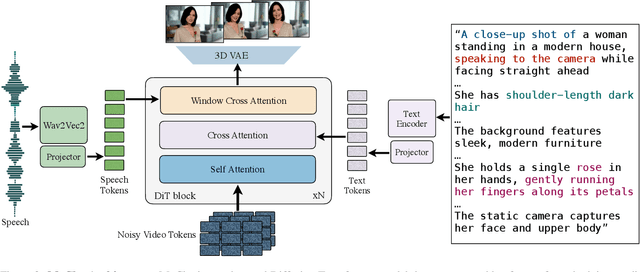
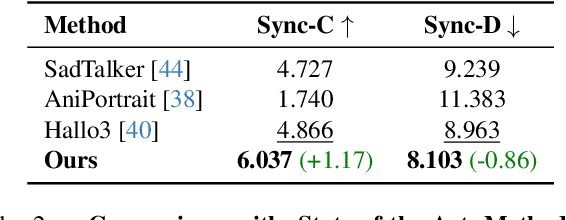
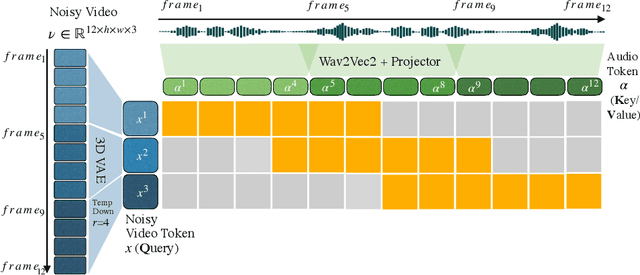
Abstract:Recent advancements in video generation have achieved impressive motion realism, yet they often overlook character-driven storytelling, a crucial task for automated film, animation generation. We introduce Talking Characters, a more realistic task to generate talking character animations directly from speech and text. Unlike talking head, Talking Characters aims at generating the full portrait of one or more characters beyond the facial region. In this paper, we propose MoCha, the first of its kind to generate talking characters. To ensure precise synchronization between video and speech, we propose a speech-video window attention mechanism that effectively aligns speech and video tokens. To address the scarcity of large-scale speech-labeled video datasets, we introduce a joint training strategy that leverages both speech-labeled and text-labeled video data, significantly improving generalization across diverse character actions. We also design structured prompt templates with character tags, enabling, for the first time, multi-character conversation with turn-based dialogue-allowing AI-generated characters to engage in context-aware conversations with cinematic coherence. Extensive qualitative and quantitative evaluations, including human preference studies and benchmark comparisons, demonstrate that MoCha sets a new standard for AI-generated cinematic storytelling, achieving superior realism, expressiveness, controllability and generalization.
Vamba: Understanding Hour-Long Videos with Hybrid Mamba-Transformers
Mar 14, 2025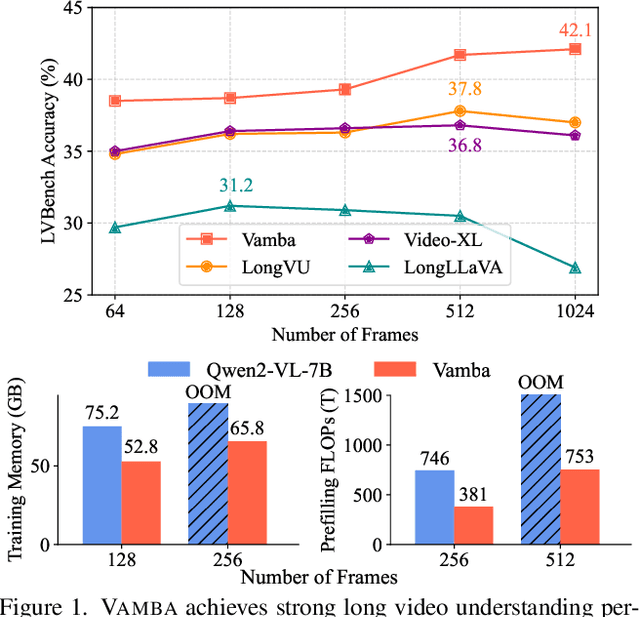

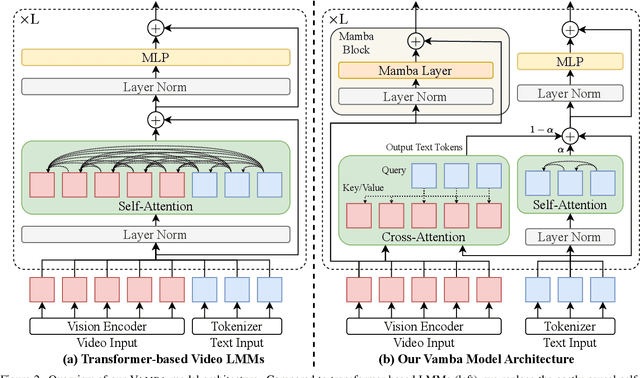
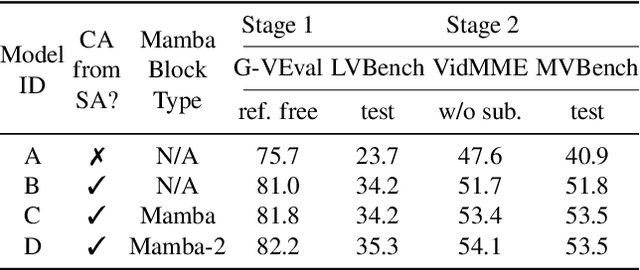
Abstract:State-of-the-art transformer-based large multimodal models (LMMs) struggle to handle hour-long video inputs due to the quadratic complexity of the causal self-attention operations, leading to high computational costs during training and inference. Existing token compression-based methods reduce the number of video tokens but often incur information loss and remain inefficient for extremely long sequences. In this paper, we explore an orthogonal direction to build a hybrid Mamba-Transformer model (VAMBA) that employs Mamba-2 blocks to encode video tokens with linear complexity. Without any token reduction, VAMBA can encode more than 1024 frames (640$\times$360) on a single GPU, while transformer-based models can only encode 256 frames. On long video input, VAMBA achieves at least 50% reduction in GPU memory usage during training and inference, and nearly doubles the speed per training step compared to transformer-based LMMs. Our experimental results demonstrate that VAMBA improves accuracy by 4.3% on the challenging hour-long video understanding benchmark LVBench over prior efficient video LMMs, and maintains strong performance on a broad spectrum of long and short video understanding tasks.
A Survey on Data-Centric AI: Tabular Learning from Reinforcement Learning and Generative AI Perspective
Feb 12, 2025


Abstract:Tabular data is one of the most widely used data formats across various domains such as bioinformatics, healthcare, and marketing. As artificial intelligence moves towards a data-centric perspective, improving data quality is essential for enhancing model performance in tabular data-driven applications. This survey focuses on data-driven tabular data optimization, specifically exploring reinforcement learning (RL) and generative approaches for feature selection and feature generation as fundamental techniques for refining data spaces. Feature selection aims to identify and retain the most informative attributes, while feature generation constructs new features to better capture complex data patterns. We systematically review existing generative methods for tabular data engineering, analyzing their latest advancements, real-world applications, and respective strengths and limitations. This survey emphasizes how RL-based and generative techniques contribute to the automation and intelligence of feature engineering. Finally, we summarize the existing challenges and discuss future research directions, aiming to provide insights that drive continued innovation in this field.
InstructSeg: Unifying Instructed Visual Segmentation with Multi-modal Large Language Models
Dec 18, 2024Abstract:Boosted by Multi-modal Large Language Models (MLLMs), text-guided universal segmentation models for the image and video domains have made rapid progress recently. However, these methods are often developed separately for specific domains, overlooking the similarities in task settings and solutions across these two areas. In this paper, we define the union of referring segmentation and reasoning segmentation at both the image and video levels as Instructed Visual Segmentation (IVS). Correspondingly, we propose InstructSeg, an end-to-end segmentation pipeline equipped with MLLMs for IVS. Specifically, we employ an object-aware video perceiver to extract temporal and object information from reference frames, facilitating comprehensive video understanding. Additionally, we introduce vision-guided multi-granularity text fusion to better integrate global and detailed text information with fine-grained visual guidance. By leveraging multi-task and end-to-end training, InstructSeg demonstrates superior performance across diverse image and video segmentation tasks, surpassing both segmentation specialists and MLLM-based methods with a single model. Our code is available at https://github.com/congvvc/InstructSeg.
VISTA: Enhancing Long-Duration and High-Resolution Video Understanding by Video Spatiotemporal Augmentation
Dec 01, 2024



Abstract:Current large multimodal models (LMMs) face significant challenges in processing and comprehending long-duration or high-resolution videos, which is mainly due to the lack of high-quality datasets. To address this issue from a data-centric perspective, we propose VISTA, a simple yet effective Video Spatiotemporal Augmentation framework that synthesizes long-duration and high-resolution video instruction-following pairs from existing video-caption datasets. VISTA spatially and temporally combines videos to create new synthetic videos with extended durations and enhanced resolutions, and subsequently produces question-answer pairs pertaining to these newly synthesized videos. Based on this paradigm, we develop seven video augmentation methods and curate VISTA-400K, a video instruction-following dataset aimed at enhancing long-duration and high-resolution video understanding. Finetuning various video LMMs on our data resulted in an average improvement of 3.3% across four challenging benchmarks for long-video understanding. Furthermore, we introduce the first comprehensive high-resolution video understanding benchmark HRVideoBench, on which our finetuned models achieve a 6.5% performance gain. These results highlight the effectiveness of our framework.
HyperSeg: Towards Universal Visual Segmentation with Large Language Model
Nov 26, 2024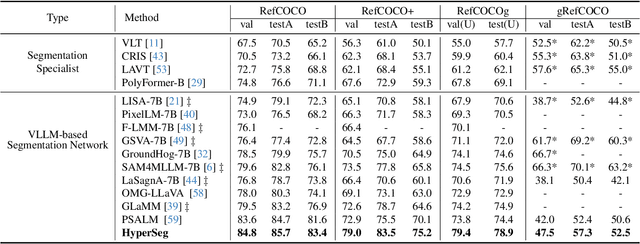
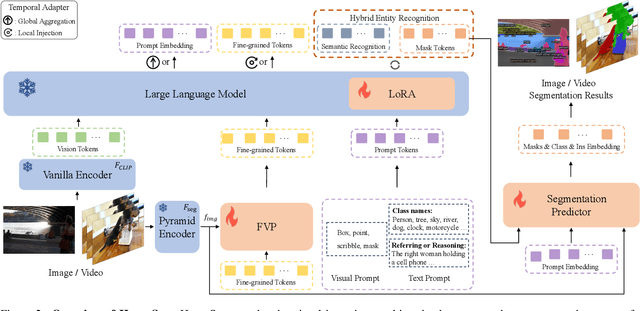


Abstract:This paper aims to address universal segmentation for image and video perception with the strong reasoning ability empowered by Visual Large Language Models (VLLMs). Despite significant progress in current unified segmentation methods, limitations in adaptation to both image and video scenarios, as well as the complex reasoning segmentation, make it difficult for them to handle various challenging instructions and achieve an accurate understanding of fine-grained vision-language correlations. We propose HyperSeg, the first VLLM-based universal segmentation model for pixel-level image and video perception, encompassing generic segmentation tasks and more complex reasoning perception tasks requiring powerful reasoning abilities and world knowledge. Besides, to fully leverage the recognition capabilities of VLLMs and the fine-grained visual information, HyperSeg incorporates hybrid entity recognition and fine-grained visual perceiver modules for various segmentation tasks. Combined with the temporal adapter, HyperSeg achieves a comprehensive understanding of temporal information. Experimental results validate the effectiveness of our insights in resolving universal image and video segmentation tasks, including the more complex reasoning perception tasks. Our code is available.
OmniEdit: Building Image Editing Generalist Models Through Specialist Supervision
Nov 11, 2024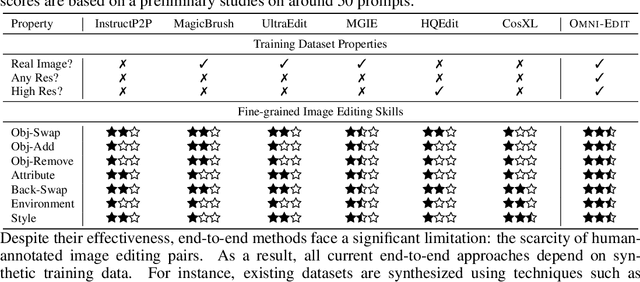
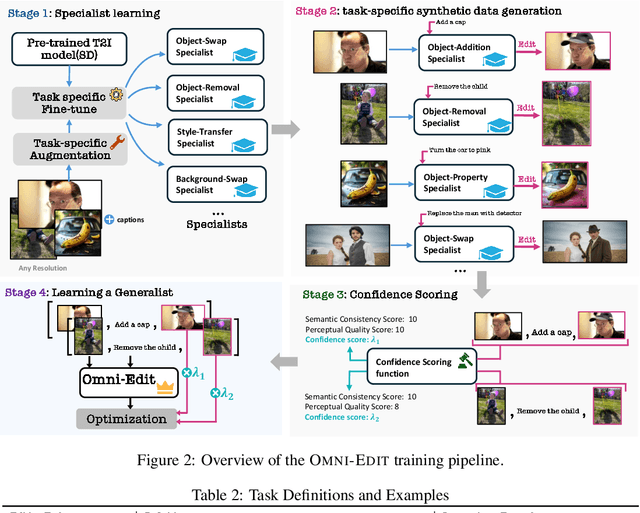
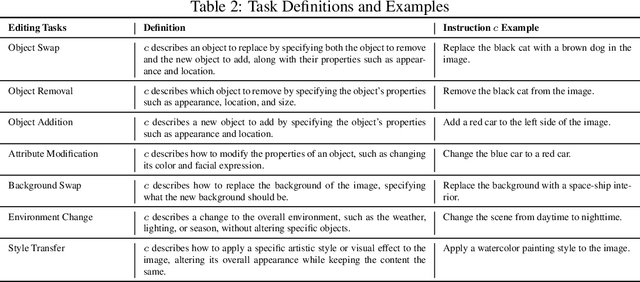
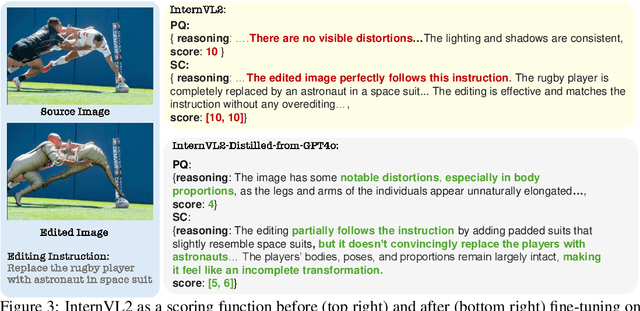
Abstract:Instruction-guided image editing methods have demonstrated significant potential by training diffusion models on automatically synthesized or manually annotated image editing pairs. However, these methods remain far from practical, real-life applications. We identify three primary challenges contributing to this gap. Firstly, existing models have limited editing skills due to the biased synthesis process. Secondly, these methods are trained with datasets with a high volume of noise and artifacts. This is due to the application of simple filtering methods like CLIP-score. Thirdly, all these datasets are restricted to a single low resolution and fixed aspect ratio, limiting the versatility to handle real-world use cases. In this paper, we present \omniedit, which is an omnipotent editor to handle seven different image editing tasks with any aspect ratio seamlessly. Our contribution is in four folds: (1) \omniedit is trained by utilizing the supervision from seven different specialist models to ensure task coverage. (2) we utilize importance sampling based on the scores provided by large multimodal models (like GPT-4o) instead of CLIP-score to improve the data quality. (3) we propose a new editing architecture called EditNet to greatly boost the editing success rate, (4) we provide images with different aspect ratios to ensure that our model can handle any image in the wild. We have curated a test set containing images of different aspect ratios, accompanied by diverse instructions to cover different tasks. Both automatic evaluation and human evaluations demonstrate that \omniedit can significantly outperform all the existing models. Our code, dataset and model will be available at \url{https://tiger-ai-lab.github.io/OmniEdit/}
MANTIS: Interleaved Multi-Image Instruction Tuning
May 02, 2024



Abstract:The recent years have witnessed a great array of large multimodal models (LMMs) to effectively solve single-image vision language tasks. However, their abilities to solve multi-image visual language tasks is yet to be improved. The existing multi-image LMMs (e.g. OpenFlamingo, Emu, Idefics, etc) mostly gain their multi-image ability through pre-training on hundreds of millions of noisy interleaved image-text data from web, which is neither efficient nor effective. In this paper, we aim at building strong multi-image LMMs via instruction tuning with academic-level resources. Therefore, we meticulously construct Mantis-Instruct containing 721K instances from 14 multi-image datasets. We design Mantis-Instruct to cover different multi-image skills like co-reference, reasoning, comparing, temporal understanding. We combine Mantis-Instruct with several single-image visual-language datasets to train our model Mantis to handle any interleaved image-text inputs. We evaluate the trained Mantis on five multi-image benchmarks and eight single-image benchmarks. Though only requiring academic-level resources (i.e. 36 hours on 16xA100-40G), Mantis-8B can achieve state-of-the-art performance on all the multi-image benchmarks and beats the existing best multi-image LMM Idefics2-8B by an average of 9 absolute points. We observe that Mantis performs equivalently well on the held-in and held-out evaluation benchmarks. We further evaluate Mantis on single-image benchmarks and demonstrate that Mantis can maintain a strong single-image performance on par with CogVLM and Emu2. Our results are particularly encouraging as it shows that low-cost instruction tuning is indeed much more effective than intensive pre-training in terms of building multi-image LMMs.
LaSagnA: Language-based Segmentation Assistant for Complex Queries
Apr 12, 2024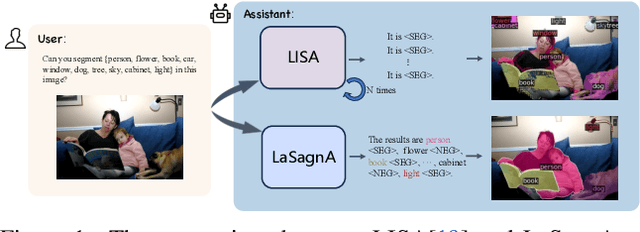

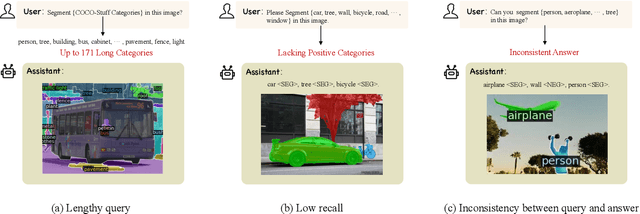
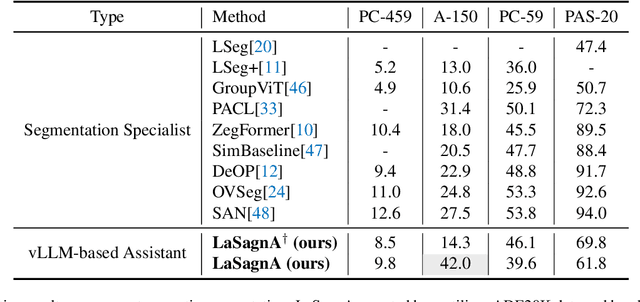
Abstract:Recent advancements have empowered Large Language Models for Vision (vLLMs) to generate detailed perceptual outcomes, including bounding boxes and masks. Nonetheless, there are two constraints that restrict the further application of these vLLMs: the incapability of handling multiple targets per query and the failure to identify the absence of query objects in the image. In this study, we acknowledge that the main cause of these problems is the insufficient complexity of training queries. Consequently, we define the general sequence format for complex queries. Then we incorporate a semantic segmentation task in the current pipeline to fulfill the requirements of training data. Furthermore, we present three novel strategies to effectively handle the challenges arising from the direct integration of the proposed format. The effectiveness of our model in processing complex queries is validated by the comparable results with conventional methods on both close-set and open-set semantic segmentation datasets. Additionally, we outperform a series of vLLMs in reasoning and referring segmentation, showcasing our model's remarkable capabilities. We release the code at https://github.com/congvvc/LaSagnA.
AnyV2V: A Plug-and-Play Framework For Any Video-to-Video Editing Tasks
Mar 22, 2024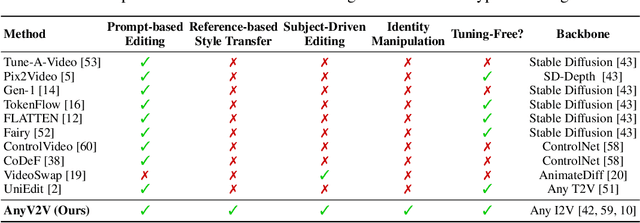
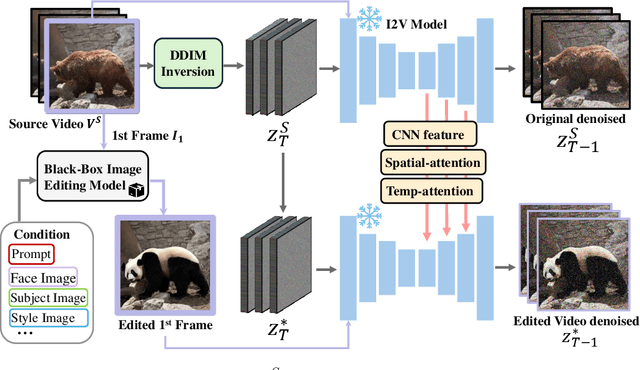
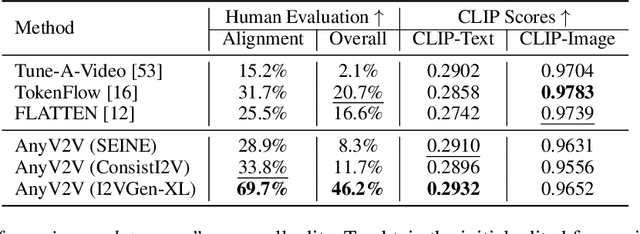
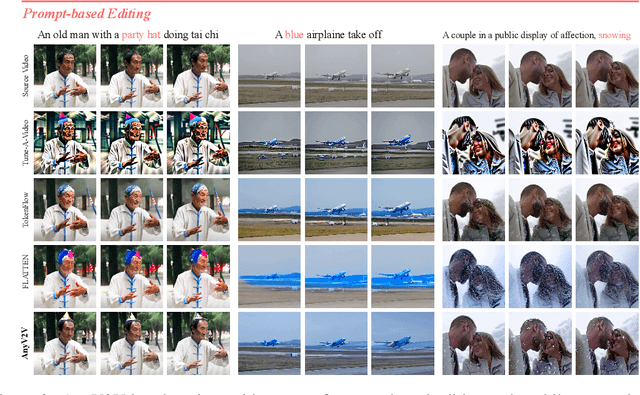
Abstract:Video-to-video editing involves editing a source video along with additional control (such as text prompts, subjects, or styles) to generate a new video that aligns with the source video and the provided control. Traditional methods have been constrained to certain editing types, limiting their ability to meet the wide range of user demands. In this paper, we introduce AnyV2V, a novel training-free framework designed to simplify video editing into two primary steps: (1) employing an off-the-shelf image editing model (e.g. InstructPix2Pix, InstantID, etc) to modify the first frame, (2) utilizing an existing image-to-video generation model (e.g. I2VGen-XL) for DDIM inversion and feature injection. In the first stage, AnyV2V can plug in any existing image editing tools to support an extensive array of video editing tasks. Beyond the traditional prompt-based editing methods, AnyV2V also can support novel video editing tasks, including reference-based style transfer, subject-driven editing, and identity manipulation, which were unattainable by previous methods. In the second stage, AnyV2V can plug in any existing image-to-video models to perform DDIM inversion and intermediate feature injection to maintain the appearance and motion consistency with the source video. On the prompt-based editing, we show that AnyV2V can outperform the previous best approach by 35\% on prompt alignment, and 25\% on human preference. On the three novel tasks, we show that AnyV2V also achieves a high success rate. We believe AnyV2V will continue to thrive due to its ability to seamlessly integrate the fast-evolving image editing methods. Such compatibility can help AnyV2V to increase its versatility to cater to diverse user demands.
 Add to Chrome
Add to Chrome Add to Firefox
Add to Firefox Add to Edge
Add to Edge